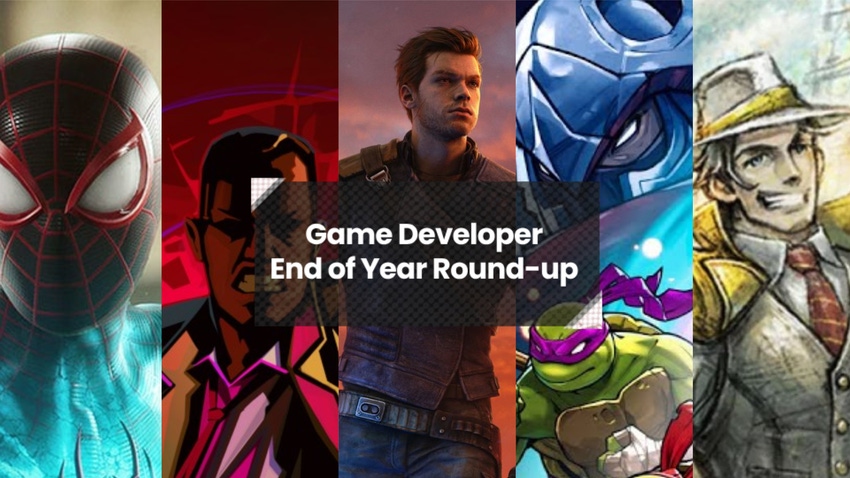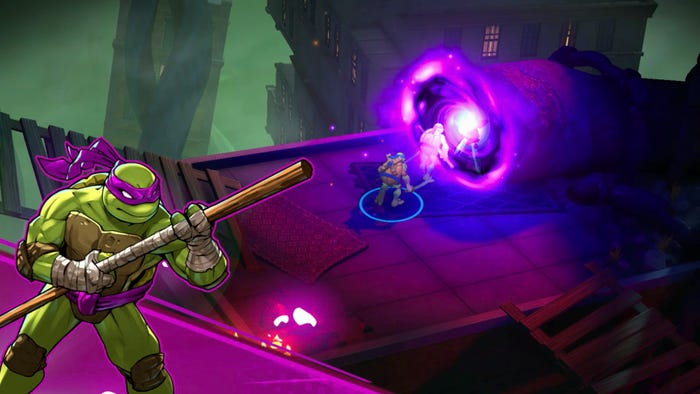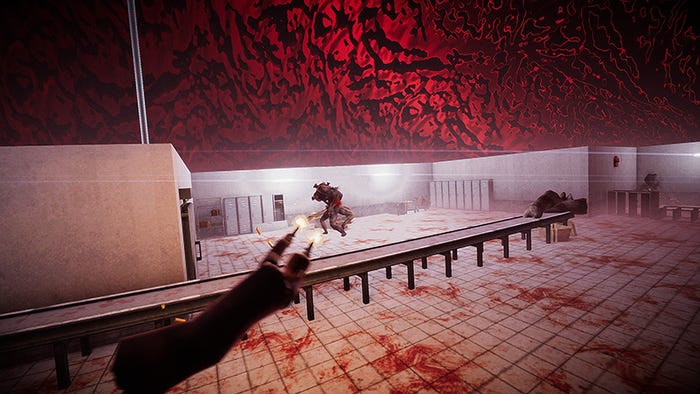
Picking your favorite anything of any year is hard, especially when it has to be more than one thing. It's even harder when so much of the year has been consistently excellent from a quality standpoint and you find yourself wishing you had more time to go back to something to give it a fair shake.
In the end, I gave it my best effort and wrote about five games that stuck in my head for whatever reason—maybe it was how much I enjoyed playing them or a particular thing they did extremely well or a character I ended up liking more than expected. With some of these, I felt myself liking the moment I heard about them, because that's just what everyone does nowadays. Others, I played because I'd heard good things about them and wanted to keep current, and unexpectedly found myself won over. It's always nice when that happens.
In the end, I wrote what I could and liked what I did. Sometimes, that's really all you can do.
Teenage Mutant Ninja Turtles: Splintered Fate (Super Evil Megacorp/Nickelodeon)

Donatello in Ninja Turtles: Splintered Fate.
The Ninja Turtles have headlined plenty of games in the past, from platform fighters to beat-em-ups. TMNT: Splintered Fate is the newest game to star the terrapin warriors, with the added novelty of being essentially a reskin of Supergiant’s 2020 hit Hades. It’s not an insult so much as it is fact: from the isometric point-of-view to its roguelike mechanics and mysterious otherworldly shopkeeper, it’s easy to see what notebook Super Evil Megacorp was looking at.
As with Hades, Splintered Fate is just a very good, very fun mobile title that’s easy to sink into. The sense of progression through each zone and region always feels earned, the offered abilities feel viable in their own way, and each Turtle feels fantastic to play. While not quite as narratively heavy as what it’s pulling from, the personality of the four leads is always present, as is the franchise’s classic charm. And while it’s presently exclusive to the Apple Arcade, the lack of monetization and a mostly consistent balance in single player makes it worth getting a membership for.
Marvel's Spider-Man 2 (Insomniac Games/Sony)

Peter Parker & Miles Morales in Marvel's Spider-Man 2.
The original Marvel’s Spider-Man felt like a jolt of energy for licensed superhero games after Rocksteady closed out the Batman Arkham franchise just a few years prior. 2020’s Spider-Man: Miles Morales was a strong solo outing for Miles, who was just starting to come into his own after the release of Spider-Man: Into the Spider-Verse.
Like the two heroes at its center, Spider-Man 2 feels like the best parts of the first two games combined, with some standout new additions. The most important is the Web Wings meant to help Peter and Miles get around New York: combined with the web-swinging and other traversal abilities, zipping around the city feels even more satisfying than it did in the previous two installments. And the open-world problems that typically plague games like these have been smoothed out: side quests help flesh out either Insomniac’s version of Marvel’s New York or the Spider-heroes relationship with the city’s people, both with consistently satisfying payoffs.
Spider-Man 2 is bigger and more bombastic than its predecessors, as all sequels must be. But even with all that, it hasn’t lost its intimate character focus or its heart that puts its characters through the wringer and throws some fun curveballs. Sometimes, a sequel showing you the franchise it’s attached to has got the goods is all you need.
Octopath Traveler II (Acquire/Square Enix)

Cover art for Square Enix's Octopath Traveler II.
In the lead-up to Final Fantasy XVI, the RPG community was at war over that franchise’s future and lamenting its abandonment of its turn-based roots. Much like Sea of Stars, Square Enix’s Octopath Traveler II provides an excellent spin on the turn-based formula with its “Break” mechanic. Specific moves and elemental attacks break an enemy’s shield, at which point they’re ripe for attack. Finding out what attacks have break potential can be a little too trial-and-error, but discovering what works (and getting the opportunity to deliver the breaking blow) is always satisfying. It’s easy enough to learn, but gains some complexity when multiple enemies have to be juggled, and serves as incentive to think about party composition.
Octopath Traveler II’s band of heroes, scoundrels, and well, travelers are all individually engaging and charming right from the outset. Their individual stories each have their own style and tone, and there’s fun in watching them interact with each other and their own supporting casts. The storytelling method also allows for a consistent sense of discovery that comes with arriving at a new region. Even if a character’s tale doesn’t continue in that area, the ability to shift between day and night at will makes each town feel lived in and real, with a sense of continuity beyond the main cast visiting.
Square Enix appears to love making mid-size RPGs like the Octopath Traveler games in the hopes they find a modest audience. I’m glad that’s the case; while I’m not that familiar with the old-school RPGs it’s pulling from, I can feel the history that Octopath Traveler II is drawing from, and the ways in which it wants to make its own legacy.
Star Wars Jedi: Survivor (Respawn/EA)

Cal Kestis in Star Wars Jedi: Survivor.
With the Titanfall games and Apex Legends, Respawn spent years cementing itself a great developer of multiplayer shooters. With Star Wars Jedi: Fallen Order from 2019 and now Star Wars Jedi: Survivor, the developer proves it has more range than one would’ve initially expected, given its primarily shooter-based pedigree.
Like Spider-Man 2, Jedi Survivor takes the “if it ain’t broke, improve it” sequel approach. Cal feels much faster and more sure of himself as a Jedi, making the Souls-like combat feel even more satisfying than its predecessor. The expanded lightsaber stances add some great dynamism to fights, in particular the split saber and incredibly goofy blaster stance. Star Wars has always thrived when the Jedi feel equal parts samurai and cowboy, and the new stances go a long way in fulfilling that particular power fantasy.
But the highlight of Survivor is just how sure in itself it is as a piece of Star Wars media. In recent years, the franchise has tripped over its own feet. But Respawn has delivered a confident sequel that largely sticks the landings it sets up and carves out a particular niche. It can comfortably do its own thing while occasionally brushing shoulders with the larger goings-on. That counts for a lot, and it also helps that it’s brought some compelling characters along for the ride.
El Paso Elsewhere (Strange Scaffold)

James Savage doing bullet time in Strange Scaffold's El Paso Elsewhere.
The PlayStation 2 era was notable for having what seemed like limitless potential as games embraced wholly being games while also clearly working off of other material. El Paso Elsewhere from developer Strange Scaffold is billed a “third-person love letter to classic shooters,” which in this case is very clearly Remedy’s Max Payne franchise. I can’t say how it stacks up to the series it draws inspiration from, which just lost its lead actor James McCaffrey. But I can say that El Paso succeeds as a throwback to the simpler days of third-person shooters where cover was inconsequential and the only special ability was Bullet Time.
As the drug-fueled vampire hunter James Savage, jumping into mid-air as time slows down to blast vampires, werewolves, and other supernatural creatures never really loses its appeal. It saves your life, it gives you a brief respite, and it just makes gunfights feel a little more thrilling when you’re already hanging by the skin of your teeth. What also helps is the appealing retro vibe of everything: it’s cosmic horror as shown in a blocky, simple style reminiscent of the PlayStation 1 and levels that are big enough to encourage exploration but not so big that you can’t easily sort yourself out just by angling the camera upwards.
Despite starring a guy who monologues about his vampire ex-girlfriend in a gravelly voice and says, “Leap like a fucking circus animal,” El Paso Elsewhere plays things as straight as is. The complete sincerity in itself makes it all the more charming and one of 2023’s most pleasant surprises.
About the Author(s)
You May Also Like









